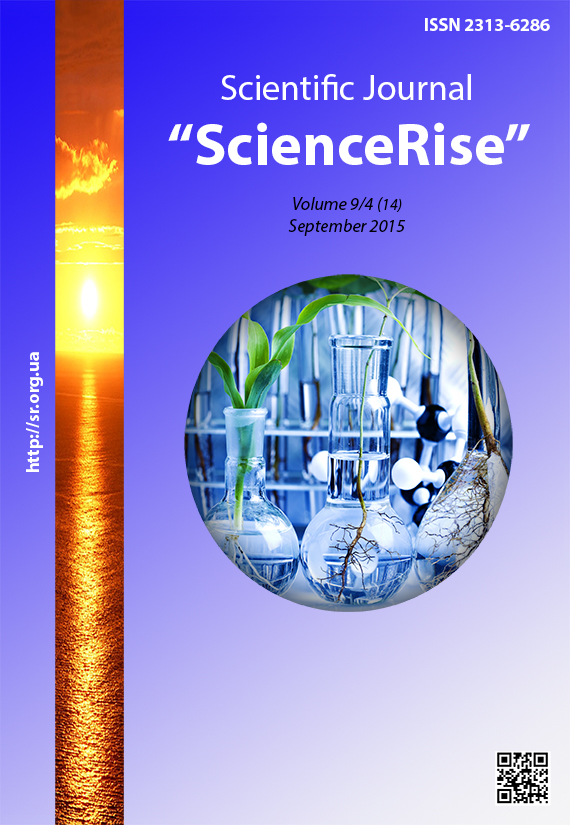Клінічні особливості перебігу гострих респіраторних вірусних інфекцій у дітей у поєднанні з патологією глоткового мигдалика
DOI :
https://doi.org/10.15587/2313-8416.2015.50551Mots-clés :
респіраторні вірусні інфекції, аденоїдні вегетації, хронічний аденоїдит, клінічні симптоми, дiтиRésumé
Досліджувалися відмінності клінічного перебігу гострих респіраторних вірусних інфекцій у дітей дошкільного віку на фоні патології глоткового мигдалика. Виявлено домінуючі симптоми, що проявлялися закладеністю носа, нічним вологим кашлем, хропіння та зниження слуху, біллю у вухах, поліаденопатією, лихоманкою із тривалістю понад 3 діб
Références
Delyahyn, V. (2009). Acute respiratory disease in children. Consilium medicum. Pediatria, 1, 24–32.
Karneeva, A. V. (2009). Prevention of fear of infections in children. Pediatric farmakology, 6 (5), 11–13.
Savenkova, M. S. (2011). The Many Faces of acute respiratory viral infection: from major pathogen for drugs. Attendingdoctor, 3, 1–8.
Selkova, E. P. (2007). New technologies in the Prevention and Treatment of acutere spiratory viral infection. Consiliummedicum, 9 (1), 72–74.
Smiian, A. I., Bynda, T. P., Dmitrova, E. V. (2013). Modern etiopathogenetical, clinical and diagnostic peculiarities of acute respiratory viral infections in children. Journal of clinical and experimental medical research, 1 (3), 328–336.
Bykova, V. P., Bruevich, A. (2007). Adenoids and adenoiditis in physiology and pathology of childhood. Archives of Pathology, 69 (4), 50–55.
Vavylova, V. P. (2003). The prospects local antibiotic Byoparoks in the program of prevention of exacerbations of chronic adenoiditis children at tending pre-schoolinstitutions. Pediatria, 4, 81–86.
Vavylova, V. P., Perevoshchikov, N. K., Garashchenko, T. I. (2004). Bioparox role in the program Prevention hypertrophy of nasopharyngeal tonsilsandadenoids exacerbations of chronic SARS insicklychildren. New medical technology, 11, 17–19.
Chistyakova, V. R. (2008). Adenoids. Moscow, 705–715.
Puhlyk, B. M. (2010). Difficulty in nasal breathing. Klyn. immunol. Allerhol. Infektol., 2, 21–28.
Maydannik, V. G. (2013). Probiotics: the prospects application in children will be rewarded. International Journal of Pediatrics, Obstetricsand Gynecology, 4 (3), 62–80.
Smiian, A. I., Bynda, T. P., Dmitrova, E. V. (2014). Clinical manifestations dyspeptic syndrome in children, acute respiratory virus infection on background of adenoid vegetations. "Rebenokandsociety: the problem of health, nutrition and development". Minsk, 134–135.
Stolyarov, D. I. (2010). Developmen to fIntegrated diagnosis and monitoring treatment chronicadenoiditis, associatedwithintestinal dysbiosis. Tver, 18.
Stolyarov, D. I. (2008). Risk factors for chronic persistent adenoiditis, clinical and functional characteristics of the patients. Russian Rhinology, 2, 50–51.
Bjornson, C. L., Johnson, D. W. (2007). Croup in the paediatric emergency department. Paediatrics & Child Health, 12 (6), 473–477.
Checchia, P. (2008). Identification and management of severe respiratory syncytial virus. American Journal of Health-System Pharmacy, 65 (23), 7–12. doi: 10.2146/ajhp080439
Lin, C.-D., Tsai, M.-H., Lin, C.-W., Ho, M.-W., Wang, C.-Y., Tsou, Y.-A. et. al (2011). Association of adenoid hyperplasia and bacterial biofilm formation in children with adenoiditis in Taiwan. European Archives of Oto-Rhino-Laryngology, 269 (2), 503–511. doi: 10.1007/s00405-011-1704-x
Yulysh, E. I. (2013). Antiviral therapy in the treatment of acute respiratory diseases in children. Modern pedyatrya, 5 (53), 75–79.
Téléchargements
Publié-e
Numéro
Rubrique
Licence
(c) Tous droits réservés Олександр Іванович Сміян, Євгенія Василівна Дмітрова, Олена Геннадіївна Васильєва 2015

Cette œuvre est sous licence Creative Commons Attribution 4.0 International.
Our journal abides by the Creative Commons CC BY copyright rights and permissions for open access journals.
Authors, who are published in this journal, agree to the following conditions:
1. The authors reserve the right to authorship of the work and pass the first publication right of this work to the journal under the terms of a Creative Commons CC BY, which allows others to freely distribute the published research with the obligatory reference to the authors of the original work and the first publication of the work in this journal.
2. The authors have the right to conclude separate supplement agreements that relate to non-exclusive work distribution in the form in which it has been published by the journal (for example, to upload the work to the online storage of the journal or publish it as part of a monograph), provided that the reference to the first publication of the work in this journal is included.

